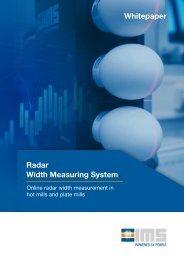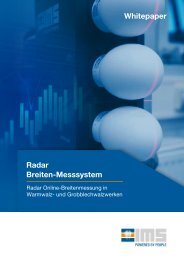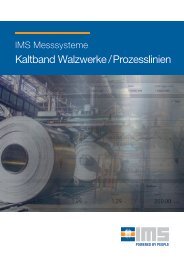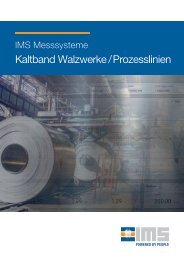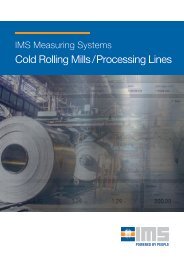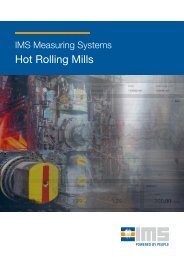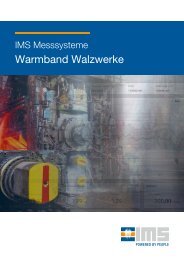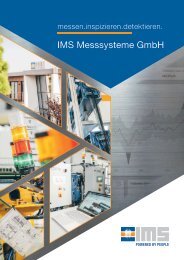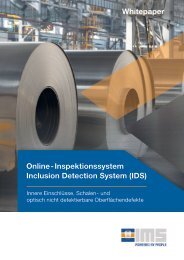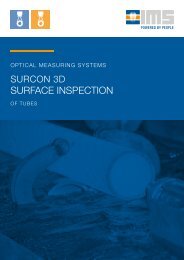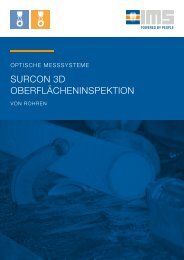Online Inspection System Inclusion Detection System IDS
Early Detection of Internal Inclusions and Shell Defects Using Magnetic Flux Leakage: IMS Messsysteme Presents Market-Ready Inclusion Detection System IDS for Cold-Rolled Strip Steel The demands placed on steel as a material are growing continuously due to the ongoing development of the material and its processing methods. This also applies to the purity of the steel. As a result, exact control of the production processes is essential for the production of high-quality end products in order to provide the finishing industry with flawless starting materials with homogeneous material structures. To be able to ensure this, it is important to determine various parameters over the entire length of the strip. A selective material inspection at the ends of the strip is not sufficient to reliably prevent material defects in the end products and possible damage to tools in the downstream forming processes. The innovative Inclusion Detection System IDS of IMS detects those defects continuously in a non-contact and non-destructive detection technique.
Early Detection of Internal Inclusions and Shell Defects Using Magnetic Flux Leakage: IMS Messsysteme Presents Market-Ready Inclusion Detection System IDS for Cold-Rolled Strip Steel
The demands placed on steel as a material are growing continuously due to the ongoing development of the material and its processing methods. This also applies to the purity of the steel.
As a result, exact control of the production processes is essential for the production of high-quality end products in order to provide the finishing industry with flawless starting materials with homogeneous material structures. To be able to ensure this, it is important to determine various parameters over the entire length of the strip.
A selective material inspection at the ends of the strip is not sufficient to reliably prevent material defects in the end products and possible damage to tools in the downstream forming processes.
The innovative Inclusion Detection System IDS of IMS detects those defects continuously in a non-contact and non-destructive detection technique.
Create successful ePaper yourself
Turn your PDF publications into a flip-book with our unique Google optimized e-Paper software.
Whitepaper<br />
<strong>Online</strong> <strong>Inspection</strong> <strong>System</strong><br />
<strong>Inclusion</strong> <strong>Detection</strong> <strong>System</strong> (<strong>IDS</strong>)<br />
Internal <strong>Inclusion</strong>s, Shell and<br />
Optically Undetectable Surface Defects
CONTENTS<br />
06<br />
Measurement Results<br />
01<br />
Introduction<br />
04<br />
Development of<br />
<strong>Inclusion</strong> <strong>Detection</strong> <strong>System</strong><br />
4.1 Sensor Technology<br />
6.1 Laboratory Measurements<br />
6.2 Operational Measurements<br />
6.3 Calibration Coil<br />
18 - 21<br />
22 - 26<br />
02<br />
07 - 10<br />
27<br />
4.2 Structure of the Sensor Block<br />
02<br />
Task<br />
4.3 Structure of the<br />
Overall <strong>System</strong><br />
11 - 13<br />
07<br />
Summary<br />
03 - 04<br />
14 - 15<br />
28 - 29<br />
03<br />
User Benefits<br />
05<br />
Technical<br />
Production Design<br />
05 - 06<br />
16 - 17<br />
2<br />
3
01<br />
Introduction<br />
02<br />
Task<br />
The exact control of production processes in the manufacture of strip steel<br />
and flat products is crucial for the production of high-quality products<br />
with homogeneous properties over their complete length. For verification,<br />
it is therefore necessary to determine various material parameters over<br />
the complete length and not just selectively at the ends. Non-contact and<br />
non-destructive testing methods are required in the running process.<br />
In steel production and the subsequent casting process, inclusions get<br />
into the melt during the metallurgical process. Some of these non-metallic<br />
particles remain in the steel products produced. In the subsequent rolling<br />
processes, these internal defects are not rolled out of the steel, but rather<br />
take on an elongated shape due to the deformation of the material.<br />
If these internal inclusions and shells do not appear as open defects on<br />
the surface of the material, they cannot be detected with conventional<br />
optical measuring systems.<br />
The demands placed on strip steels as a<br />
material are growing continuously due to<br />
the ongoing development of the material<br />
and processing methods. This also applies<br />
to the degree of purity. In the cold strip<br />
sector, even the smallest purity deficiencies<br />
or inclusions have negative effects.<br />
The relative magnetic permeability of such<br />
inclusions is significantly lower than that<br />
of the surrounding material. Based on this<br />
physical fact, detection by magnetic flux<br />
leakage is possible.<br />
In this process, the tested material is<br />
magnetised, whereby a homogeneous<br />
magnetic field also results on its surface<br />
if its structure is homogeneous. If there are<br />
local areas in the material with significantly<br />
lower permeability, caused by, for example,<br />
non-metallic inclusions, cracks and indentations<br />
on the surface, the magnetic<br />
In concrete terms, material defects in the form of internal inclusions and<br />
shell defects in manufacturing processes with high degrees of deformation<br />
– such as deep drawing – lead to material fractures, an increased reject<br />
and complaint rate, considerable disruptions to the production process,<br />
and even cost-intensive damage to the tools.<br />
Figure 1: Schematic illustration of the magnetic field profile in the case of an internal inclusion<br />
02<br />
INTRODUCTION<br />
TASK<br />
03
esistance increases at this point. A part of the magnetic flux is<br />
thus forced to the surface of the material. The difference between<br />
the relative permeability of the material and the surrounding air<br />
results in pronounced magnetic refraction. The extent of the<br />
stray field emerging from the material surface is therefore significantly<br />
greater than the causal defect, which enables its detection.<br />
Accordingly, the task included the technical and mechanical<br />
development of a new on-line measuring system based on the<br />
principle of magnetic leakage flux, which reliably detects and<br />
visualises these internal inclusions and shell defects already<br />
formed during the metallurgical process.<br />
03<br />
User Benefits<br />
In accordance with these requirements,<br />
the <strong>Inclusion</strong> <strong>Detection</strong> <strong>System</strong> (<strong>IDS</strong>) from<br />
IMS Messsysteme GmbH, which is unique<br />
on the market, detects these defects continuously<br />
during the ongoing production process<br />
without contact and non-destructively<br />
for strip thicknesses of 0.1 to 1 mm. This<br />
system is therefore particularly interesting for<br />
manufacturers of tin plates and thin sheets<br />
metal who, for example, have to guarantee<br />
the highest quality standards for the automotive<br />
or food industries.<br />
In contrast to an optical surface inspection<br />
system, the <strong>Inclusion</strong> <strong>Detection</strong> <strong>System</strong><br />
(<strong>IDS</strong>) – as already described – is also able<br />
to detect defects lying completely within<br />
the material for which there are no discernible<br />
signs on the material surface.<br />
However, the technology of magnetic<br />
leakage flux applied here offers a further,<br />
convincing advantage:<br />
Surface defects such as cracks or roll<br />
impressions that are too small in size or<br />
insufficient in contrast for detection by<br />
optical surface inspection are also magnetically<br />
visible due to material stresses or<br />
interruptions in the microstructure.<br />
Some surface defects, such as shells and<br />
scrap marks, often have significantly larger<br />
extensions than are optically detectable on<br />
the material surface. In contrast to an optical<br />
surface inspection, the <strong>Inclusion</strong> <strong>Detection</strong><br />
<strong>System</strong> (<strong>IDS</strong>) detects the full extent of such<br />
defects, as outlined in the following figure:<br />
04 TASK<br />
USER BENEFITS 05
Safely detectable area<br />
Conditionally detectable area<br />
Not detectable area<br />
Optical Surface <strong>Inspection</strong> <strong>System</strong><br />
<strong>Inclusion</strong> <strong>Detection</strong> <strong>System</strong> (<strong>IDS</strong>)<br />
using magnetic flux leakage principle<br />
04<br />
Development of an<br />
<strong>Inclusion</strong> <strong>Detection</strong> <strong>System</strong> (<strong>IDS</strong>)<br />
4.1 Sensor Technology<br />
Based on this, the optical measurements of surface defects on<br />
sample sheets presented in the remainder of the white paper are<br />
assumed to be representative of internal and surface defects.<br />
When operating an <strong>Inclusion</strong> <strong>Detection</strong> <strong>System</strong> (<strong>IDS</strong>) and a<br />
conventional surface inspection system together on (non-ferromagnetic)<br />
coated material, the <strong>IDS</strong> enables reliable discrimination<br />
between coating and substrate defects because, unlike an SIS,<br />
it only displays defects in the ferromagnetic substrate.<br />
The flux leakage detection system<br />
developed for the detection of internal<br />
inclusions offers the functionality of a<br />
complete flux leakage test during ongoing<br />
production operation. Electromagnets<br />
are used to magnetise the material. Their<br />
power can be adapted to the properties,<br />
structure and geometry of the material<br />
being inspected and can be switched off<br />
for maintenance and cleaning purposes.<br />
The stray fields are detected by means of<br />
GMR sensors. The sensors used are GMR<br />
differential sensors (gradiometers). They<br />
consist of 4 individual GMR sensors that<br />
are connected in the form of a Wheatstone<br />
measuring bridge. Two of these sensors<br />
each are linked spatially as shown in Figure<br />
2. A differential signal is formed in dependence<br />
on the difference in magnetic field<br />
strength between the two sensitive areas.<br />
The sensitive areas of the sensors used<br />
have a centre-to-centre distance of 1 mm.<br />
V0<br />
Exit 2<br />
Exit 1<br />
0<br />
Figure 2: GMR differential sensor<br />
06 USER BENEFITS<br />
DEVELOPMENT OF AN INCLUSION DETECTION SYSTEM | SENSOR TECHNOLOGY 07
The use of gradiometers enables a significantly<br />
higher amplification compared<br />
to absolute sensors (magnetometers) as<br />
external fields have no influence on the<br />
sensor signal. This means that particularly<br />
small local magnetic field inhomogeneities<br />
can be detected.<br />
In the <strong>IDS</strong> measuring system, the material<br />
is magnetised transversely to rolling direction.<br />
This direction of magnetisation was chosen<br />
on the basis of laboratory measurements<br />
with artificial defects. These defects were<br />
defined as through holes of different<br />
diameters as well as grooves with a length<br />
of 1 mm, a width of 100 µm and variable<br />
depth. The internal inclusions occurring in<br />
cold-rolled strip normally take on elongated<br />
shapes due to the strong deformation.<br />
Grooves, therefore, correspond most<br />
closely to the defects that actually occur.<br />
For holes, which correspond to compact<br />
defects, approximately equivalent results<br />
were obtained with all magnetisation<br />
directions. For grooves, significantly better<br />
signal-to-noise ratios were obtained with<br />
magnetisation transverse to the rolling<br />
direction. This can easily be explained by<br />
the larger defect cross-section in this direction.<br />
Figure 3 and 4 show the signal-to-noise<br />
ratios for a through hole with a diameter<br />
of 100 µm and a groove with a depth of<br />
25 µm, a width of 100 µm and a length<br />
of 1 mm.<br />
- Magnetization<br />
- Magnetization<br />
Figure 4: SNR of a 100 µm through hole at different magnetisation directions and measuring distances<br />
Magnetisation at a 45° angle to rolling magnetic field homogeneity, the yoke width<br />
direction is not a compromise, as this was chosen so that a 48 mm wide area is<br />
worsens the signal-to-noise ratio for measured in each case.<br />
compact defects compared to parallel<br />
magnetisation, without improving the Consequently, multiple magnets are necessary<br />
in order to cover the different material<br />
signal-to-noise ratio for elongated defects.<br />
widths. Since no measurement is possible<br />
With magnetisation transverse to the rolling in the area of the pole shoes of the<br />
direction, the maximum yoke width of the magnets, the sensor modules are arranged<br />
magnet is limited. Due to a suitable in two rows for continuous coverage.<br />
Figure 3: SNR of a groove 25 µm deep, 100 µm wide and 1 mm long at different magnetisation directions and measuring distances<br />
08<br />
DEVELOPMENT OF AN INCLUSION DETECTION SYSTEM | SENSOR TECHNOLOGY<br />
DEVELOPMENT OF AN INCLUSION DETECTION SYSTEM | SENSOR TECHNOLOGY<br />
09
Figure 5 shows the dependence of the<br />
signal-to-noise ratio on the distance<br />
between the sensor and strip surface.<br />
Starting from a minimum air gap of 200<br />
µm, the ratio decreases almost linearly<br />
by about 1 dB / 100 µm additional air gap as<br />
the distance increases. In practice, an air gap<br />
of 700 µm is sufficient for this application and<br />
resolution.<br />
04<br />
4.2 Structure of the Sensor Block<br />
One magnet and the sensor line inside<br />
each magnet were combined to form a<br />
compact sensor module. This guarantees<br />
easy maintenance, repair and scalability<br />
of the measuring system.<br />
quick-release clamps in conjunction with<br />
fitting screws. Mechanical adjustment is<br />
not necessary thanks to the precise manufacture<br />
and assembly of the individual<br />
module components.<br />
Figure 6 shows an opened module with its<br />
key components. A module contains the<br />
sensors, the amplification and filtering of<br />
the sensor signals, AD converters as well<br />
as the control of the electromagnet and<br />
stabilised voltage supplies. The sensor<br />
modules are installed quickly and reproducibly<br />
on the measuring system using<br />
The GMR sensors are encapsulated into a<br />
sensor block within a protective and stabilising<br />
aluminium frame. This hinders adhesion<br />
of dirt and provides protection against<br />
mechanical damage. The sensor modules<br />
comply with protection class IP 64, which<br />
enables direct use in harsh environments.<br />
Figure 5: Signal-to-noise ratio of grooves and holes in dependence on the measuring distance<br />
Figure 6: Sensor module<br />
10 DEVELOPMENT OF AN INCLUSION DETECTION SYSTEM | SENSOR TECHNOLOGY<br />
DEVELOPMENT OF AN INCLUSION DETECTION SYSTEM | STRUCTURE OF THE SENSOR BLOCK 11
Figure 7: Sensor block open<br />
Figure 8: Sensor block encapsulated<br />
Figure 10: Signal amplitude of a 1 mm x 100 µm x 30 µm groove depending on<br />
its position.<br />
For compact small defects, for example holes, the stray field is optimal for detection<br />
with this sensor arrangement.<br />
Figure 9: Replacement of sensor block<br />
Compared to smaller sensors with higher spatial resolution, the sensors used are more<br />
sensitive. This means that particularly weak signals of small defects can be detected<br />
better. The defects detected by a sensor are determined via the signal amplitude.<br />
The modular design ensures easy replacement<br />
of the sensor block without<br />
adjustment work.<br />
A sensor module has an outer width of<br />
95 mm, which allows two sensor module<br />
rows to cover the material without gaps.<br />
Each sensor module contains 48 GMR<br />
differential sensors in the centre of the<br />
magnet. The distance between the sensors<br />
transversely to rolling direction is 1 mm.<br />
This is advantageous as the size of the<br />
stray fields of the smallest defects is also<br />
above 1 mm. Figure 10 shows the signal<br />
amplitude of a 1 mm long, 100 µm wide<br />
and 30 µ deep groove.<br />
Figure 11: Signal amplitude of different defects depending on their volume<br />
12 DEVELOPMENT OF AN INCLUSION DETECTION SYSTEM | STRUCTURE OF THE SENSOR BLOCK<br />
DEVELOPMENT OF AN INCLUSION DETECTION SYSTEM | STRUCTURE OF THE SENSOR BLOCK<br />
13
04<br />
4.3 Structure of the Overall <strong>System</strong><br />
The overall system is structured hierarchically. The individual levels work on a task basis<br />
and are interconnected via fast network technology. The sensor signals are converted<br />
from analogue to digital with a sampling rate of up to 187.5 kHz at a resolution of 15 bits.<br />
Length-dependent scanning takes place with a constant longitudinal resolution (rolling<br />
direction) of 0.1 mm.<br />
The digitised sensor signals from up to eight sensor modules are fed to a common<br />
Gig-E hub and converted to the Gig-E camera standard.<br />
Figure 12: Hardware structure<br />
The Gig-E hubs are connected to a camera computer. This camera computer has<br />
the following tasks:<br />
1. Signal pre-processing<br />
2. <strong>Detection</strong> of defects<br />
3. Feature computation<br />
4. Classification<br />
5. Control and adjustment of the sensor modules<br />
The database server is superimposed on this camera computer. The database server<br />
stores the defect images and contains the production and training database. Visualisation<br />
of the defects as well as the connection to the customer database is effected via the<br />
database server.<br />
Figure 13: Signal processing<br />
Figure 13 shows the signal processing with the detection, classification and<br />
post-processor functions.<br />
14 DEVELOPMENT OF AN INCLUSION DETECTION SYSTEM | STRUCTURE OF THE OVERALL SYSTEM<br />
DEVELOPMENT OF AN INCLUSION DETECTION SYSTEM | STRUCTURE OF THE OVERALL SYSTEM<br />
15
05<br />
Technical Production Design<br />
Product data:<br />
Strip thickness<br />
0.1 – max. 1 mm<br />
Strip width<br />
customizable<br />
Strip speed<br />
max. 1,000 m/min. at full resolution<br />
Measuring distance > 0.5 mm<br />
Measuring accuracy:<br />
Detectable defect size Hole: 70 µm diameter; groove: 10 µm deep, 100 µm wide,<br />
(substitute defect) 1,000 µm long in strip 250 µm thick.<br />
The minimum defect size must be determined depending<br />
on the application.<br />
Distance influence 1 dB / 100 µm<br />
Reproducibility >98%<br />
The measurement takes place on a deflection roller with two rows of sensor modules.<br />
The sensor modules can be adjusted to different material thicknesses with the help of<br />
servo motors.<br />
To ensure mechanical stability, the sensor<br />
module rows and their carriers are kept at<br />
a constant temperature by means of water.<br />
The water cooling also serves to dissipate<br />
the waste heat of the sensor modules.<br />
The measuring system also has a pneumatic<br />
drive to move the sensor rows on and off<br />
the strip surface completely. The drive is<br />
activated automatically for quick retraction<br />
of the measuring system from the strip<br />
surface if there is a risk of collision with the<br />
material being measured.<br />
The distance of the sensor modules to the<br />
strip surface is monitored permanently by<br />
three capacitive distance sensors per sensor<br />
module row. As an additional safety device,<br />
the measuring system has an optical<br />
wrinkle detector. This is a laser light barrier<br />
which is installed in the strip run 10-20 m<br />
in front of the measuring point. In the case<br />
of wrinkles, the sensor rows are swivelled<br />
away.<br />
The measuring system can be moved to<br />
park position outside the system. In this<br />
position, the sensors are adjusted automatically<br />
and maintenance work can be<br />
carried out while the line is running. During<br />
the adjustment, all sensors are standardised<br />
to a defined magnetic sensitivity and defective<br />
sensors are detected.<br />
Figure 14: <strong>Inclusion</strong> <strong>Detection</strong> <strong>System</strong> in operation<br />
16 TECHNICAL PRODUCTION DESIGN<br />
TECHNICAL PRODUCTION DESIGN<br />
17
06<br />
Surface defects on the opposite side of the material to the measuring system can also be<br />
detected. Figure 17 shows the raw signal of grooves measuring 1 mm x 100 µm x 25 µm<br />
in 200 µm thick steel strip. The first groove is on the side of the material facing the measuring<br />
system, the second on the opposite side.<br />
Measurement Results<br />
6.1 Laboratory Measurements<br />
The following figures show the raw signals of artificial defects: a hole with a diameter of<br />
100 µm (Figure 15) and a surface groove measuring 1 mm x 100 µm x 30 µm in 200 µm<br />
thick steel strip at a measuring distance of 500 µm and a speed of 500 m/min.<br />
Figure 18: Groove signal profile, top and bottom strip side<br />
Signal curve of a 100 µm<br />
through hole<br />
Signal curve of a 30 µm deep,<br />
100 µm wide and 1 mm long groove<br />
As can be seen in Figure 19, the speed has only little influence on the signal-to-noise<br />
ratio of defect signals.<br />
Signal to noise ratio at variable material speed,<br />
100 μm through hole<br />
Signal curve of a 10 µm deep,<br />
100 µm wide and 1 mm long groove<br />
Speed<br />
Figure 19: Signal profile at different speeds<br />
Figures 15 – 17:<br />
Signal profiles of a 100 μm hole and 10 μm and 30 μm deep,<br />
100 μm wide and 1 mm long groove<br />
18 MEASUREMENT RESULTS | LABORATORY MEASUREMENTS<br />
MEASUREMENT RESULTS | LABORATORY MEASUREMENTS<br />
19
The following figures show the signal characteristics of grooves with a width of 100 µm<br />
and a depth of 25 µm and 50 µm respectively, as well as a hole with a diameter of 100 µm<br />
in 800 µm. As can be seen from the 50 µm groove, the sensitivity for defects located on<br />
the underside of the material is reduced at this material thickness, but larger defects can<br />
still be detected on both sides.<br />
The following figures show examples of cold strip defects visible visually without the aid<br />
of a magnetic particle inspection, with the associated <strong>IDS</strong> signals:<br />
Figure 20:<br />
Signal characteristic of a<br />
25 µm deep and 100 µm<br />
wide groove on the upper<br />
side of the material<br />
Figure 24:<br />
Small shell, material depth 700 µm<br />
Figure 21:<br />
Signal characteristic of<br />
a 50 µm deep and 100<br />
µm wide groove on the<br />
upper side of the<br />
material<br />
Figure 25:<br />
Signal characteristic, small shell<br />
Figure 22:<br />
Signal characteristic<br />
of a 50 µm deep and<br />
100 µm wide groove on<br />
the under side of the<br />
material<br />
Figure 26:<br />
Rolling and coating defect,<br />
material depth 660 µm<br />
Figure 23:<br />
Signal characteristic of<br />
a 100 µm hole<br />
Figure 27:<br />
Signal characteristic, rolling<br />
and coating defect<br />
20 MEASUREMENT RESULTS | LABORATORY MEASUREMENTS MEASUREMENT RESULTS | LABORATORY MEASUREMENTS 21
06<br />
6.2 Operational Measurements<br />
The internal inclusions measured are evaluated as follows:<br />
1. Based on defect size (amplitude/volume)<br />
2. Based on classification<br />
e.g. shells, cracks, overlaps, M-defects, scratches, indentations<br />
Figure 29: Large defects such as scratches and wrinkles<br />
Some inclusions detected were located precisely by means of magnetic<br />
particle inspection and examined subsequently by making 3 sections each<br />
transverse to the rolling direction.<br />
Figure 28: Compact defects, various representations<br />
Figure 30: <strong>IDS</strong> image of defect 1 Figure 31: Magnetic particle image of defect 1<br />
22<br />
MEASUREMENT RESULTS | OPERATIONAL MEASUREMENTS<br />
MEASUREMENT RESULTS | OPERATIONAL MEASUREMENTS<br />
23
Figure 37: 1st section, defect 2 Figure 38: 2nd section, defect 2 Figure 39: 3rd section, defect 2<br />
Figure 32: 1st section, defect 1 Figure 33: 2nd section, defect 1 Figure 34: 3rd section, defect 1<br />
Figure 35: <strong>IDS</strong> image of defect 2 Figure 36: Magnetic particle image of defect 2<br />
Figure 40: <strong>IDS</strong> image of defect 3<br />
Figure 41: Magnetic particle image of defect 3<br />
24 MEASUREMENT RESULTS | OPERATIONAL MEASUREMENTS<br />
MEASUREMENT RESULTS | OPERATIONAL MEASUREMENTS<br />
25
06<br />
6.3 Calibration Coil<br />
The complete measuring system, including the classification<br />
performance, is checked cyclically by means of a<br />
calibration coil. The calibration coil should contain as<br />
many defects as possible. Cold strip from the production<br />
of transitional slabs is suitable for this. A reproducibility<br />
of > 98% was achieved during the cyclical check.<br />
Figure 42: 1st Section, defect 3<br />
Figure 43: 2nd section, defect 3 Figure 44: 3rd section, defect 3<br />
26 MEASUREMENT RESULTS | OPERATIONAL MEASUREMENTS<br />
MEASUREMENT RESULTS | CALIBRATION COIL<br />
27
07<br />
Summary<br />
Using high-quality measuring electronics and<br />
advanced image processing, a high-resolution<br />
measuring system for internal defects<br />
and external material damage has been<br />
developed.<br />
The <strong>IDS</strong> measuring system is used for complete<br />
evaluation of purity. The maximum strip<br />
thickness at full sensitivity is 1 mm and is<br />
scalable to any strip width. The measuring<br />
system can be adapted to customer specifications.<br />
The image processing with feature computation<br />
and classification used distinguishes the<br />
defects based on their size and type. The<br />
classification is adapted to the respective<br />
material and the customer specification.<br />
The <strong>IDS</strong> measuring system avoids the delivery<br />
of defective material and ensures perfect<br />
product quality for the end customer. In addition,<br />
the measurement results are used to optimise<br />
the pre-material stages. By improving<br />
quality and output, resources are conserved<br />
and costs reduced.<br />
28 SUMMARY<br />
SUMMARY 29
IMS Messsysteme GmbH<br />
Dieselstraße 55<br />
42579 Heiligenhaus | Germany<br />
Phone: +49 (0) 2056 / 975 – 0<br />
Fax: +49 (0) 2056 / 975 – 140<br />
Mail: info@ims-gmbh.de<br />
www.ims-gmbh.de | www.ims-experts.com | www.imsocial.info




